East Austin plaque unveiled to remember lynching victims
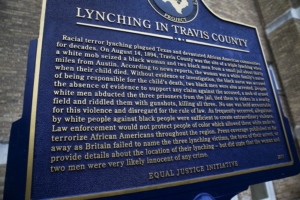
The Alabama-based Equal Justice Initiative plans to install similar plaques in other communities that had lynchings between the Reconstruction period and 1950.
(Austin American-Statesman) The details of the Travis County lynching in 1894, based on news accounts from the time, are discouragingly sparse. Even the victims’ names are lost to history.
An African-American woman working as a nurse for a white family was jailed after one of the children in her care died. Two African-American men, for reasons no longer known, were arrested as well. A white mob formed on Aug. 14, 1894, and abducted the woman and the two men from a jail about 30 miles from Austin, taking them a field. There, they were tied to stakes and riddled with bullets.
No one was jailed for the killings. News reports at the time indicated that the three victims “very likely” were innocent of any crimes.
About 250 gathered Saturday afternoon (Dec. 16) in an East Austin church to remember those anonymous deaths. Later, under a steady, cold rain, most of those people huddled outside as Austin NAACP President Nelson Linder, Travis County Commissioner Jeff Travillion, Austin Mayor Steve Adler and U.S. Rep. Lloyd Doggett unveiled a blue-and-gold plaque in front of Wesley United Methodist Church. The plaque, headlined “Lynching in Travis County,” is the seventh such remembrance installed by the Alabama-based Equal Justice Initiative nationwide and the first from that group in Texas. (more)
Historic African American neighborhood evolved into San Antonio’s East Side
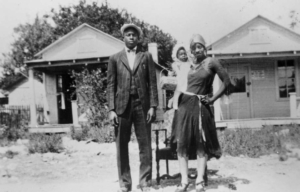
Loil Ellison and wife, Estella Ellison, and daughter Estella Mae Ellison stand in front of their house at 520 Callaghan Ave., in early the 1930s. In the background are shotgun-style houses, across the street at 519 (left) and 521 Callaghan Ave., in a neighborhood demolished to make way for the Victoria Courts public housing project.
(San Antonio Express-News) When Annie Ellison Sance stepped up to her past, she fell to her knees and clasped her hands in prayer.
Tears rolled down her cheeks as she brushed her fingers across the image of her parents, Loil and Estella Mae Ellison, engraved in a sidewalk on South Presa Street. She wept over the young, fashionably dressed couple, frozen forever in front of their home in the 700 block of Barrera Street during the 1920s.
“It is so emotional,” she said. “My mother and father will be embedded there forever.”
Sance’s son-in-law Clarence Thomas poured a jug of water across the concrete square, knelt and scrubbed away debris as his wife, Marion, comforted her mother. Another square featured a quote from a family journal that reads, “We came from Lockhart to San Antonio in an old Model-T truck …. We moved into the Baptist Settlement, Callaghan Avenue.”
The neighborhood no longer exists. All that remains of the city’s earliest African-American community are traces of the settlement that evolved into the East Side community.
“It’s been a transitional area,” Thomas said. “The old churches don’t celebrate it, almost like a part of history was just erased.” (more)
Literary: “The color of law, A Forgotten History of How Our Government Segregated America”
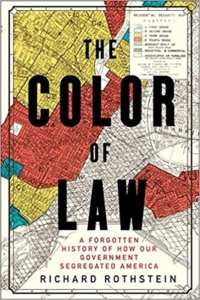 This “powerful and disturbing history” exposes how American governments deliberately imposed racial segregation on metropolitan areas nationwide (New York Times Book Review).
This “powerful and disturbing history” exposes how American governments deliberately imposed racial segregation on metropolitan areas nationwide (New York Times Book Review).
Widely heralded as a “masterful” (Washington Post) and “essential” (Slate) history of the modern American metropolis, Richard Rothstein’s The Color of Law offers “the most forceful argument ever published on how federal, state, and local governments gave rise to and reinforced neighborhood segregation” (William Julius Wilson).
Exploding the myth of de facto segregation arising from private prejudice or the unintended consequences of economic forces, Rothstein describes how the American government systematically imposed residential segregation: with undisguised racial zoning; public housing that purposefully segregated previously mixed communities; subsidies for builders to create whites-only suburbs; tax exemptions for institutions that enforced segregation; and support for violent resistance to African Americans in white neighborhoods. A groundbreaking, “virtually indispensable” study that has already transformed our understanding of twentieth-century urban history (Chicago Daily Observer), The Color of Law forces us to face the obligation to remedy our unconstitutional past. (more)
TIPHC Bookshelf
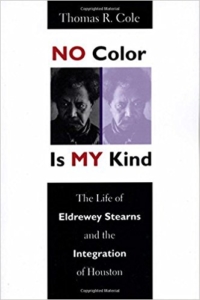 Published scholarship on black history in Texas is growing and we’d like to share with you some suggested readings, both current and past, from some of the preeminent history scholars in Texas and beyond. We invite you to take a look at our bookshelf page – including a featured selection – and check back as the list grows. A different selection will be featured each week. We welcome suggestions and reviews. This week, we offer, “No Color Is My Kind, The Life of Eldrewey Stearns and the Integration of Houston,” by Thomas R. Cole.
Published scholarship on black history in Texas is growing and we’d like to share with you some suggested readings, both current and past, from some of the preeminent history scholars in Texas and beyond. We invite you to take a look at our bookshelf page – including a featured selection – and check back as the list grows. A different selection will be featured each week. We welcome suggestions and reviews. This week, we offer, “No Color Is My Kind, The Life of Eldrewey Stearns and the Integration of Houston,” by Thomas R. Cole.
No Color Is My Kind is an uncommon chronicle of identity, fate, and compassion as two men-one Jewish and one African American-set out to rediscover a life lost to manic depression and alcoholism.
In 1984, Thomas Cole discovered Eldrewey Stearns in a Galveston psychiatric hospital. Stearns, a fifty-two-year-old black man, complained that although he felt very important, no one understood him.
Over the course of the next decade, Cole and Stearns, in a tumultuous and often painful collaboration, recovered Stearns’ life before his slide into madness-as a young boy in Galveston and San Augustine and as a civil rights leader and lawyer who sparked Houston’s desegregation movement between 1959 and 1963.
While other southern cities rocked with violence, Houston integrated its public accommodations peacefully. In these pages appear figures such as Thurgood Marshall, Martin Luther King, Jr., Leon Jaworski, and Dan Rather, all of whom-along with Stearns-maneuvered and conspired to integrate the city quickly and calmly.
Weaving the tragic story of a charismatic and deeply troubled leader into the record of a major historic event, Cole also explores his emotionally charged collaboration with Stearns. Their poignant relationship sheds powerful and healing light on contemporary race relations in America, and especially on issues of power, authority, and mental illness.
This Week in Texas Black History, Dec. 17-23
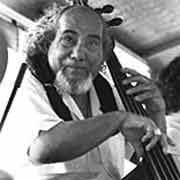
Walter Booker
Dec17
On this day in 1933, jazz bassist Walter Booker was born in Prairie View, Texas. Booker moved to Washington, D.C. at an early age when his father joined the faculty at Howard University. Booker became an elite bassist playing with many prominent jazz performers, including Sarah Vaughan, Chick Corea, Donald Byrd, Sonny Rollinsand Thelonius Monk. Booker played on more than 275 albums and in the late 1950s, while serving in the Army in Europe, was in the same unit as Elvis Presley.
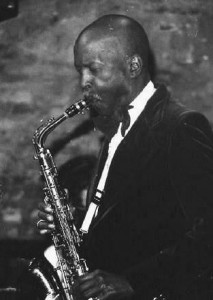
Eddie “Cleanhead” Vinson
Dec18
Saxophonist and blues singer Eddie “Cleanhead” Vinson was born on this day in 1917 in Houston. Vinson was still a student at Jack Yates High School when he began his professional career with Chester Boone’s band in 1935. Working with Milt Larkin’s band, the next year, Vinson teamed with Arnett Cobb and Illinois Jacquet to form the group’s sax section. Vinson also wrote two Miles Davis classics, “Tune Up” and “Four.” In the early 1950s, Vinson’s own band included a young John Coltrane.
Dec19
On this date in 1963, the Mary A. Brown High School Leopards football team in Smithville won the Prairie View Interscholastic League Class 1A state championship, the only state football title in Smithville history. Brown, coached by Gene Sampson, finished the season with a 12-1 record after crushing Mineola’s McFarland Bears, 38-6, making Brown the Class A state Negro schoolboy football champions.
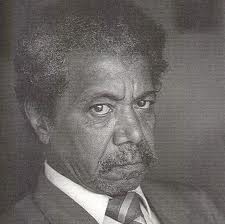
Eldrewey Stearns
Dec21
On this day in 1931, Eldrewey Stearns was born in Galveston. In 1960, Stearns became the first president of the Progressive Youth Association at Texas Southern University and led the group’s demonstrations against discrimination in various Houston facilities. The group was successful in opening access for African Americans in downtown stores, and their demonstrations against employment discrimination opened jobs for blacks at drugstores, service stations and banks in the city’s black communities.
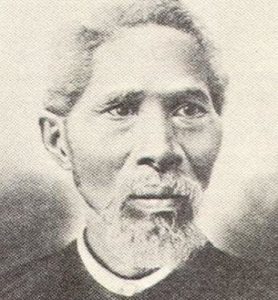
Rev. John Henry “Jack” Yates
Dec22
On this day in 1897, Rev. John Henry “Jack” Yates died in Houston. Yates, a former slave, was born in Virginia but migrated to Texas when his wife’s master moved to Matagorda County in 1863. After emancipation, Yates moved his family to Houston where he became the first pastor of Antioch Missionary Baptist Church, the first black Baptist church in Houston. He also organized the first Baptist association for blacks in Houston. Jack Yates High School is named in his honor.
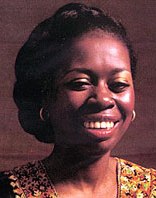
Esther Mae Jones
Dec23
Singer Esther Mae Jones was born in Galveston on this day in 1935. As “Little Esther,” she began her professional career at age 13. She changed her last name to Phillips in 1962. In 1975, she recorded her biggest hit single, “What a Difference a Day Makes,” which ranked in the top 10 of both the R&B and pop charts.
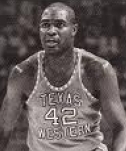
David Lattin
Dec23
On this day in 1943, David Lattin was born in Houston. Lattin graduated from segregated Evan E. Worthing High School where he was twice named a high school All-American, the first such honor for any Texas prep basketball player. Afterwards, he was the starting center for Texas Western (now UT- El Paso) on its historic 1966 national championship team that upset No. 1-ranked Kentucky and its legendary coach, Adolph Rupp. Lattin has been inducted to both the Texas Black Sports Hall of Fame and the Naismith Memorial Basketball Hall of Fame.
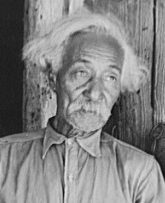
Bob Lemmons
Dec23
Bob Lemmons (or, Lemons) died on this day in 1947. Called “the most original mustanger,” by author J. Frank Dobie, Lemmons was born into slavery in Lockport, Caldwell County in 1848, but freed at age 17 in Carrizo Springs in Southwest Texas. He moved to Eagle Pass to work and learn from rancher Duncan Lemmons, and adopted his mentor’s last name. Bob Lemmons became known for his ability to track and gather wild horses by isolating himself from humans and riding with a wild herd until they accepted his presence. He then took control of the herd by mounting the lead stallion and leading the herd into a corral on a nearby ranch. The picture book Black Cowboy, Wild Horses is based on accounts from Lemmons.
Blog: Ron Goodwin, Ph.D., author, PVAMU history professor
Ron Goodwin’s bi-weekly blog appears exclusively for TIPHC. Goodwin is a San Antonio native and Air Force veteran. Generally, his column addresses contemporary issues in the black community and how they relate to black history. He and the TIPHC staff welcome your comments.
Latest Entries
A New Hope
Forgive me for borrowing the title of one of the most profitable films in history, “Star Wars: A New Hope.” I’ve always been enamored by space. I’m a child of the 1960s and I remember playing with my Major Matt Mason action figure (not a doll!) as my family [...]
Tell me the truth
Democracy – a) government by the people, b) a government in which the supreme power is vested in the people and exercised by them, directly or indirectly through a system of representation usually involving periodically held free elections. Merriam-Webster Dictionary There were many things I learned from my father. [...]
Submissions Wanted
Historians, scholars, students, lend us your…writings. Help us produce the most comprehensive documentation ever undertaken for the African American experience in Texas. We encourage you to contribute items about people, places, events, issues, politics/legislation, sports, entertainment, religion, etc., as general entries or essays. Our documentation is wide-ranging and diverse, and you may research and write about the subject of your interest or, to start, please consult our list of suggested biographical entries and see submission guidelines. However, all topics must be approved by TIPHC editors before beginning your research/writing.
We welcome your questions or comments. Please contact Mr. Michael Hurd, Director of TIPHC, at mdhurd@pvamu.edu.
